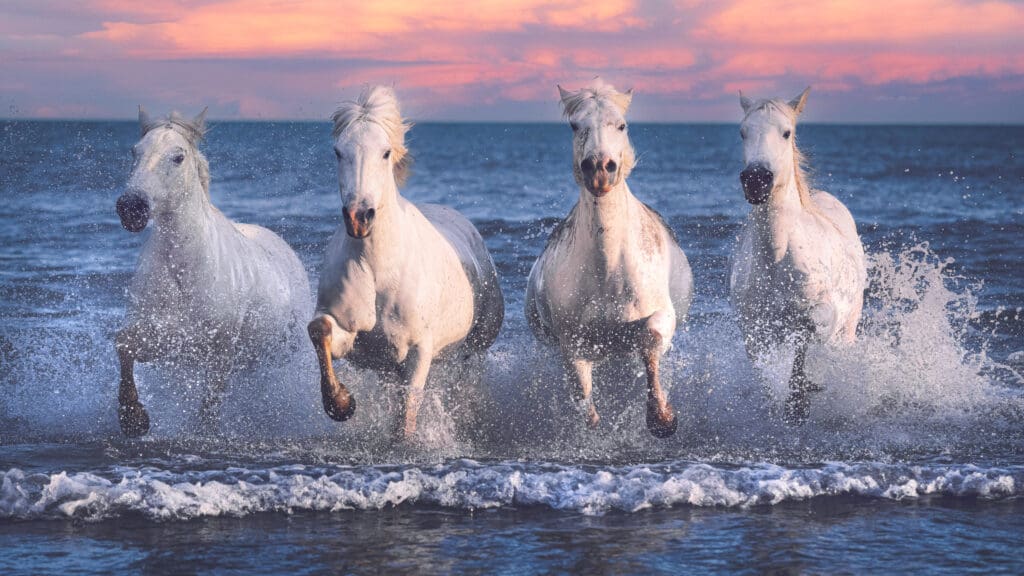Photographing the Camargue horses takes more than technical skill—it’s about understanding the relationship between these animals, their environment, and the traditions they represent. These iconic white horses roam the wetlands of southern France, a region where history, culture, and nature are deeply intertwined. With a thoughtful approach and a sense of curiosity, your camera can capture not just their beauty but the essence of their story.
Here’s a guide based on my time in the Camargue, from timing your shoots to working with local guides, and how embracing challenges can lead to unforgettable images.
Timing Your Shots
When it comes to photographing the Camargue horses, light is everything. The soft, golden hues of sunrise and sunset transform the marshes into a glowing stage, perfect for highlighting the horses’ elegant forms.
Golden Hours:
The warm light at sunrise and sunset enhances the horses’ white coats and creates striking contrasts. Arrive early to set up, and stay late to capture the shifting mood of the scene.
Morning Mists:
On cooler mornings, mist often rises from the wetlands. This natural filter can lend an ethereal quality to your images, softening the light and adding a sense of mystery.
Weather Variations:
Don’t dismiss overcast or rainy days. The diffuse light on cloudy days prevents harsh shadows, and rain can add texture and drama to your shots, especially when the horses gallop through water.
Techniques for Movement and Mood
Camargue horses are known for their grace and power, especially when running through the marshes. Capturing this energy requires a mix of technical skill and creative instinct.
Shutter Speeds: To freeze their motion, use speeds of 1/1000s or faster. If you want to show movement, experiment with slower speeds and panning.
Angles: Shooting from a low angle can make the horses appear larger and more imposing, while eye-level shots create a feeling of intimacy.
Continuous Shooting Mode: Horses move unpredictably, especially in a group. Use your camera’s burst mode to increase your chances of capturing the perfect moment. (I prefer back button focus)
Double Exposures: If you’re looking to break away from traditional photography, try layering two images. In my work, double exposures allowed me to blend surrealism with the real, offering a fresh perspective on the horses and their surroundings. Tip: Try overlaying textures over subjects and searching for contrasting themes.
Working with Local Guides
One of the best decisions I made during my time in the Camargue was working alongside local Gardians (cowboys of the region). Their knowledge of the land and the horses’ behavior made all the difference in capturing authentic moments.
Access to Private Lands: Many of the best shooting locations are on private property. A guide can provide access and ensure you’re in the right place at the right time.
Safety First: While the horses are used to human presence, they are still animals with their own instincts. Gardians know how to manage the herd and keep everyone—humans and horses—safe.
Learning Their Story: Spending time with the Gardians isn’t just practical; it’s inspiring. Their dedication to preserving this heritage enriches your understanding of the Camargue and the animals you’re photographing.
The Creative Challenges
Photographing in the Camargue isn’t always straightforward. Rain, mud, and unpredictable animals can test your patience and adaptability. But it’s in these challenges that creativity flourishes.
One rainy morning, I went out despite the weather, unsure if I’d make anything worthwhile. The mist clung to the marshes, and the horses were grazing quietly. Then, just as the sun began to rise, the Gardians encouraged the herd to run. The spray of water, the light breaking through the mist—it all came together in an instant. It’s moments like this that remind me why I love what I do.
Closing Thoughts
The Camargue offers an unparalleled opportunity to grow as a photographer. The connection between the horses, the Gardians, and the landscape is unique, offering layers of meaning to explore through your lens. Whether you’re drawn to the quiet moments of connection or the energy of a galloping herd, this region holds something extraordinary for those willing to seek it out.
Above all, approach this work with respect—for the horses, the people, and the land itself. The Camargue isn’t just a beautiful place; it’s a living story waiting to be told.
Happy shooting!

